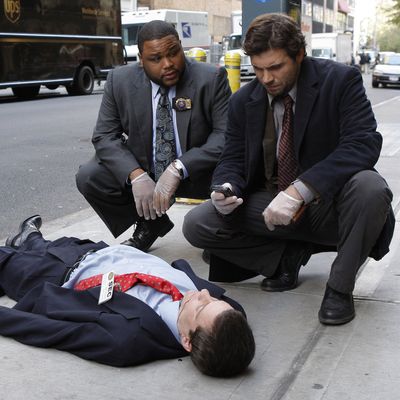
When Law & Order premiered on a quiet Thursday night in 1990, the show was fairly unassuming. Created by Dick Wolf, the series offered an in-depth look at the New York City criminal-justice system with “ripped from the headlines” story lines. While the split “Law” and “Order” format of the show — detective work in the first half, prosecutorial action in the second — was originally created in an effort to sell syndication rights for an hourlong show to traditionally 30-minute-block networks (per Wolf’s 2003 book, Law & Order: Crime Scenes), the formula quickly became an essential part of the franchise’s gimmick. The TV behemoth came to influence not only the various Law & Order spinoffs (including Special Victims Unit, Criminal Intent, Trial by Jury, LA, and Organized Crime) but police procedurals as a whole for years to come.
Over time, Law & Order’s greatest appeal — predictability — proved to be its biggest obstacle. There’s a comforting familiarity in the rhythms of the series (despite all the murder). But this leaves little room for long-term development especially with frequently rotating casts. Unlike SVU, the most successful franchise installment, the original show doesn’t have a Mariska Hargitay type guiding viewers through every season. Although Law & Order remained a staple of prime-time television, ratings began to plummet about 15 years in, and NBC canceled the mother ship in its 20th season after 456 episodes. The show is the second-longest-running live-action scripted TV series, surpassed only by SVU.
Nearly 12 years later, the original Law & Order is back. Returning to NBC Thursday night, the reboot (of sorts) stars Hugh Dancy, Jeffrey Donovan, Odelya Halevi, and Camryn Manheim. Anthony Anderson and Sam Waterston are slated to reprise their roles as Detective Kevin Bernard and attorney Jack McCoy, respectively. In honor of the return of Law & Order, we’ve rounded up 20 essential episodes from the show’s original run.
Law & Order is streaming on Peacock.
“Everybody’s Favorite Bagman” (Season 1, Episode 6)
Although “Everybody’s Favorite Bagman” is the sixth episode of Law & Order to ever air, it’s actually the original pilot and better serves the show as an introduction. The episode is gritty (literally — it was shot in the late ’80s and shopped to another network) and follows the mugging and consequential death of a local councilman and erstwhile bagman. Although it seems like a typical mugging, the crime quickly turns into a far-reaching case of corruption featuring a mobster, a deputy police commander, and an undercover wire operation gone awry.
The episode is a solid who’s who of the show’s main players: Sergeant Max Greevey (George Dzundza), Detective Mike Logan (Chris Noth), Captain Donald Cragen (SVU’s Dann Florek), Executive Assistant District Attorney Ben Stone (Michael Moriarty), and Assistant District Attorney Paul Robinette (Richard Brooks). District Attorney Adam Schiff (Steven Hill) would join later. Logan is new(er) to the squad, so Greevey gets to show him — and viewers — the ropes.
“Indifference” (Season 1, Episode 9)
It takes a little while for Law & Order to find it’s rhythm, but an early standout is “Indifference.” When Greevey and Logan are put on a child-abuse case, they find a variety of problems at home including drug use and a long history of physical abuse. Things take a turn for the worse when the girl dies as a result of her injuries. When Stone attempts to charge the parents, the mother simply points fingers at the father, who denies everything. The case, which would nowadays fall under SVU’s purview, was the show’s way of stepping outside of the typical police-procedural murder tropes and into more nuanced territory.
“Point of View” (Season 3, Episode 9)
If there’s one character who defines the original Law & Order, it’s Detective Lennie Briscoe (Jerry Orbach). A straightforward Vietnam veteran who stayed honest despite several corrupt partners, Briscoe is best known for his one-liners. He joins the series in “Point of View,” when he teams up with Logan to investigate a shooting outside a bar. The victim winds up having mob ties, and it’s revealed that his hookup was paid to murder him. Elaine Stritch guest stars as attorney Lanie Stieglitz and wound up winning an Emmy for the episode.
“American Dream” (Season 4, Episode 8)
Law & Order picks up speed in season four for several reasons, chief among them the addition of Lieutenant Anita Van Buren (S. Epatha Merkerson) and ADA Claire Kincaid (Jill Hennessy). The two mark the show’s first female series regulars, and Van Buren went on to be the longest-serving main cast member of all time. “American Dream” is the first standout episode with the new team. When a fresh corpse is found during a historical dig, the detectives struggle to discover the dead man’s identity. Once they do, they find that his killer (Željko Ivanek) has already been put behind bars, and the recent discovery pokes enough holes in his case to warrant a new trial despite the fact that he definitely killed the man.
“Mayhem” (Season 4, Episode 17)
“Mayhem” delivers exactly what that episode title promises in the form of five murders throughout one episode. Briscoe and Logan’s busy day kicks off when a male model is found dead in a car with a bullet in his brain, a half-naked woman nearby. Chaos ensues as each additional murder crops up. The most memorable of the cases features a woman who cuts off her husband’s penis in a send-up to the real-life Lorena Bobbitt case of 1993. The team struggles to determine whether the woman was a victim of abuse, which will affect how Kincaid pleads her out.
“Second Opinion” (Season 5, Episode 1)
The introduction of EADA Jack McCoy marks a defining era shift for Law & Order. Briscoe and Van Buren are firmly settled in, and the old guard of the first few seasons are on their way out. In “Second Opinion,” the cops and hazmat team are called to the hospital when a recently deceased woman begins to emit a suspicious smell and a doctor falls unconscious. While the detectives initially suspect the dead woman’s husband of poisoning her, they discover she was battling cancer and turned to a woman offering alternative treatment methods. The episode focuses most on McCoy and Kincaid as they attempt to prosecute the “doctor,” who has a long history of providing dubious treatment to desperate cancer patients.
“Pro Se” (Season 6, Episode 21)
When several people are murdered by a sword-wielding killer, Briscoe and Detective Ray Curtis (Benjamin Bratt) find the prime suspect in a man dealing with schizophrenia. Although Law & Order’s treatment of mental illnesses and disorders evolves over the years, the highly sensationalized “Pro Se” inspired several similar plots across the franchise. The man (Denis O’Hare), who is revealed to have a law degree, dismisses his lawyer and defends himself against Kincaid and McCoy in court. The case causes quite a dustup between Schiff and Kincaid.
“Aftershock” (Season 6, Episode 23)
“Aftershock” is the Law & Order episode to define all Law & Order episodes and perhaps the greatest example of what the show can achieve when it applies itself. It’s a departure from the show’s typical format and follows Briscoe, Curtis, Kincaid, and McCoy in their off-duty time after they witness the execution of a man they put away. All four struggle to put the case behind them: Curtis entertains the idea of an affair when he meets a young woman (Jennifer Garner) and Briscoe, a recovering alcoholic, winds up drunk at a bar. Kincaid picks him up and starts to drive him home, but their car is struck by a drunk driver, and Kincaid dies. It’s the first time the show kills off a main character, underscoring the show’s theme of the often cruel mundanity of death.
“Showtime” (Season 7, Episode 17)
Season seven (which won the show its only Outstanding Drama Series Emmy in a stacked procedural lineup that included Chicago Hope, ER, NYPD Blue, and The X-Files) isn’t remembered as the best-ever season of Law & Order, but it’s strong across the board, especially in the “Hollywood trilogy” episodes. The arc, which features Lauren Graham, takes Briscoe and Curtis to Los Angeles, where they investigate the murder of a film executive. The trilogy wraps up with “Showtime,” when the team takes a big-name Hollywood director to trial for the murder. Curtis and ADA Jamie Ross (Carey Lowell) face separate personal struggles that threaten their home lives.
“Baby, It’s You” (Season 8, Episode 6)
The JonBenét Ramsey case is a favorite in the Law & Order universe, and almost all versions of the franchise have put their own spin on the case (Special Victims Unit handled it in season four and Criminal Intent in season six). “Baby, It’s You” follows Briscoe and Curtis as they investigate the murder of a child model. The episode is also a crossover of sorts with Homicide: Life on the Streets when Baltimore detectives John Munch (Richard Belzer) and Paul Falsone (Jon Seda) join the case. Munch transfers the next year and joins Cragen in SVU after Homicide comes to an end.
“Killerz” (Season 10, Episode 2)
In “Killerz,” Briscoe and Detective Ed Green (Jesse L. Martin) investigate the unsettling murder of a little boy. The case takes a turn for the unexpected when two young female witnesses seem to have been involved with the death. When McCoy tries to have one girl — a 10-year-old with sadistic tendencies — committed, it turns into a game of resident Law & Order psychiatrist Emil Skoda (J.K. Simmons) versus resident Law & Order psychologist Elizabeth Olivet (Carolyn McCormick) as they debate her fate and any chance at rehabilitation and treatment.
“Hubris” (Season 11, Episode 9)
Law & Order viewership peaked in seasons 11 through 13, and intense, guest-character-driven episodes like “Hubris” are part of the reason why. When a charming, smooth-talking con man (Tim Guinee) goes on trial for murder, he decides to defend himself. McCoy and ADA Abbie Carmichael (Angie Harmon) are thrown for a loop when he begins to use his charm on the jury and openly flirt with the forewoman while in court.
“Open Season” (Season 13, Episode 7)
“Open Season” begins at the end of a case as a jury finds an alleged cop shooter not guilty. Hours later, the defendant’s attorney is murdered. Briscoe and Green are faced with a wealth of subjects including fellow officers and an extremist group. Tovah Feldshuh reprises her Emmy-nominated role as defense attorney Danielle Melnick, who is tasked with defending a white supremacist. Melnick’s longtime love-hate relationship with McCoy makes her one of his most enjoyable adversaries and makes it all the more alarming when she becomes embroiled in the crime by the end of the episode.
“Couples” (Season 13, Episode 23)
“Couples” is, more than anything, an ode to the never-ending supply of crimes Law & Order characters seem to face. Briscoe and Green can’t catch a break and end up at the center of three (then four) separate murders and a kidnapping all in one day. One crime leads into another, usually accidentally, and Briscoe even delivers a baby. The ridiculousness of the situation seems to be a nod to the show’s seemingly endless bank of gruesome murders, but Briscoe and Green play it off with matching “It is what it is” attitudes.
“C.O.D.” (Season 14, Episode 24)
Briscoe’s last day (and Orbach’s last episode) is a bittersweet affair. As Green and Briscoe investigate a murdered package deliverer, the latter looks on with nostalgia and eventually admits he’s putting in his papers. The partners investigate all three women — a wife and two affairs — in the dead man’s life before finding another murder victim with a similarly wronged wife. The two wives appear to have “helped” each other, but McCoy and ADA Serena Southerlyn (Elisabeth Röhm) struggle to make a case against both of the women. The team eventually comes out on top, and Briscoe remarks, “It’s nice to go out on a win.” He gives one last look back before leaving the squad room. (Orbach died later that year.)
“Ain’t No Love” (Season 15, Episode 13)
Briscoe’s departure marked a time of free fall for the series. Seasons 15 through 17 are wholly unmemorable with the exception of “Ain’t No Love.” The episode — which follows the investigation into the murder of a rapper — is the best example of the bonkers, “Let’s see what sticks” attitude that defined the first few years post-Briscoe. Southerlyn butts heads with the team throughout the case and is fired by DA Arthur Branch (Fred Dalton Thompson) in the last scene. Completely out of the blue and with no prior personal insight to the character, she delivers what has become one of the most iconic lines in the series: “Is this because I’m a lesbian?” (It’s not.)
“Burn Card” (Season 18, Episode 14)
The quality of the show gets slightly better starting in season 18 for a variety of reasons including substantial cast shake-ups. In addition to the season 17 addition of ADA Connie Rubirosa (Alana de la Garza), the show brings on Detective Cyrus Lupo (Jeremy Sisto) and EADA Michael Cutter (Linus Roache) in season 18. They help breathe new life into the series, which is most obvious in “Burn Card.”
When a gambling addict and part-time referee is murdered after fixing a game, a suspect emerges from Green’s past. When Green kills the man, he’s investigated by internal affairs and put in front of a grand jury, where his gambling problems are revealed. With IA, the final addition to Law & Order is introduced — a reluctant Detective Kevin Bernard (Anderson). Green is eventually cleared and proven to have been protecting a woman he cared about, but he still departs the force and the series. Later in the season, Bernard replaces him on the squad.
“By Perjury” (Season 19, Episode 9)
When a plaintiff in a massive airline class-action lawsuit is murdered, his lawyer (Dallas Roberts) looks to be the prime suspect. He proves to be a deadly litigator in court and gets the main evidence against him thrown out on a technicality. The gaffe sheds a bad light on Lupo, who — as a first-year law student — should have known better than to obtain evidence from a sealed file without a court order. Cutter and Rubirosa are embarrassed in court, and the former lashes out at Lupo, telling him he’s “not that good” at being a lawyer. They eventually make a case (and several past cases) against him, and in a last-ditch attempt at revenge, the perp tries to shoot Cutter at the urinal. Lupo saves him, and the two resolve their differences.
“Just a Girl in the World” (Season 20, Episode 2)
The series truly starts to pick back up in season 20 even though low ratings had already put the nail in the Law & Order coffin. It’s largely because of the decision to begin focusing on the characters’ personal lives again, an attribute that has helped SVU remain the strongest franchise installment. In “Just a Girl in the World,” things get personal when a crime-scene technician is found murdered in her apartment. Up until now, Lupo’s main personality trait is loving his dog, so it’s a genuine shock when he begins sleeping with a victim turned suspect and jeopardizes the entire case. During the episode, Van Buren is diagnosed with cervical cancer from HPV transmitted by her ex-husband, setting up her season-long arc.
“Rubber Room” (Season 20, Episode 23)
In the season and series finale, a blogger credibly threatens to blow up an NYC school. The cops and lawyers work together to hunt down the perp, who they believe to be a high-school student with grudges against his teachers. They wind up at the “Rubber Room,” a dead-end temporary reassignment center where teachers accused of misconduct are sent to wait out their days, and realize their would-be bomber might be a maligned teacher.
Meanwhile, Van Buren is strapped for cash because of her cancer treatments. When Lupo overhears, he organizes a fundraiser. She struggles with both the never-ending nature of her treatment and the prospect of accepting help from her co-workers. In the last scene, at the fundraiser (a bittersweet send-off for the show), Van Buren announces she’s engaged, and it’s implied her cancer is in remission. The twisty episode features everything people love about Law & Order: ride-or-die squad-room camaraderie, a melodramatic bad guy who likes to rant, a McCoy monologue for the ages, and a high-stakes final confrontation.




